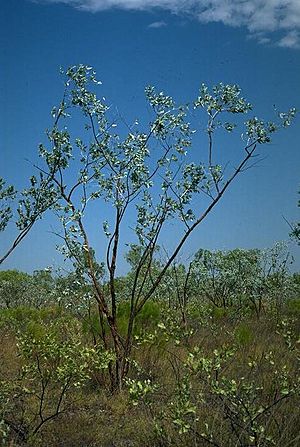Seppelt Range gum facts for kids
Quick facts for kids Seppelt Range gum |
|
|---|---|
 |
|
| Conservation status | |
| Scientific classification | |
| Genus: |
Eucalyptus
|
| Species: |
ceracea
|
The Seppelt Range gum (scientific name: Eucalyptus ceracea) is a special type of small tree or bush. It is also known as the Seppelt Range yellow-jacket. This unique plant is found only in a small area in the north of Western Australia. It has thick, rough bark on its trunk and bigger branches. Its dull, waxy leaves grow in pairs. The plant also has flower buds that grow in groups, bright orange flowers, and fruit shaped like an urn. The leaves, buds, and fruit are all covered with a white, waxy layer.
Contents
What the Seppelt Range Gum Looks Like
The Seppelt Range gum is a small tree, often with many stems. It can also grow as a "mallee." A mallee is a type of eucalyptus that grows like a bush with many thin stems coming from the ground. This plant usually grows to be about 3 to 6 metres (10 to 20 feet) tall. It has a special woody swelling at its base called a lignotuber. This helps the plant regrow after a fire.
The trunk and most of the branches have thick, rough bark. This bark can be yellowish to reddish-brown. Young plants and new shoots have egg-shaped leaves. These leaves are about 60 to 100 mm (2.4 to 3.9 inches) long and 30 to 55 mm (1.2 to 2.2 inches) wide. They grow in pairs directly on the stem, meaning they have no stalks. These leaves are dull and covered in a waxy, greyish-white coating, which is called "glaucous." Older trees keep these same types of leaves; they do not grow different "adult" leaves.
The flower buds grow in groups of seven or nine. Each group is on a main stalk called a peduncle, which is 12 to 40 mm (0.5 to 1.6 inches) long. Each individual bud has a small stalk called a pedicel, up to 5 mm (0.2 inches) long. When the buds are ready to open, they are oval or pear-shaped. They are about 15 to 17 mm (0.6 to 0.7 inches) long and about 6 mm (0.2 inches) wide. The top part of the bud, which covers the flower, is called an operculum. It is rounded or cone-shaped.
The Seppelt Range gum has been seen flowering in June. Its flowers are a bright orange colour. After the flowers, the plant produces woody fruits. These fruits are shaped like an urn and are 17 to 33 mm (0.7 to 1.3 inches) long and 11 to 17 mm (0.4 to 0.7 inches) wide. Like the leaves and buds, the fruits are also covered in a white, waxy layer.
How the Seppelt Range Gum Got Its Name
The scientific name Eucalyptus ceracea was first officially described in 1986. Two scientists, Ian Brooker and Christopher Done, described it. They found a sample of the plant south of the King George Falls in the Kimberley region.
The description was published in a science journal called Nuytsia. The second part of the scientific name, ceracea, comes from a Latin word. The Latin word cereus means "wax" or "waxy." This name was chosen because the plant's leaves, buds, and fruits are covered in a white wax.
Where the Seppelt Range Gum Lives
The Seppelt Range gum is found in sandy soils on rocky slopes and sandstone ridges. It lives in a small area near the coast in the eastern Kimberley region of Western Australia. Other plants that grow near it include spinifex (a type of grass) and other trees like Eucalyptus tectifica, E. tetrodonta, and Erythrophleum chlorostachys.
This plant is only known from two groups of plants. Both groups are found in the Seppelt Range, which is north of Wyndham. Both of these areas are on land that belongs to the Aboriginal Land Trust. We don't know the exact number of adult plants, but the total area where they grow is less than 50 square kilometres (19 square miles).
Protecting the Seppelt Range Gum
The Seppelt Range gum is listed as "vulnerable" by the Australian Government. This means it is at risk of becoming extinct if we don't protect it. It is also listed as "Threatened Flora" by the Department of Environment and Conservation (Western Australia).
The biggest dangers to this plant are mining activities, fires that happen too often or at the wrong time, and the fact that it only grows in a very small area.


